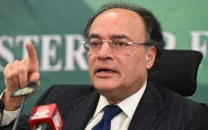Rupee may stabilise at 285/$
Appreciation beyond this level could lead to widening of trade, current account deficits

Taking cue from a lot of happenings, the consistently strengthening Pakistani currency is projected to stabilise around the level of Rs285 to a US dollar in the inter-bank market.
Any appreciation beyond that level will make imports cheaper and exports expensive, which will result in the widening of trade and current account deficits and an increase in the demand for dollars.
The gradual slowdown in the sale of dollars by exporters, drop in the future value of dollar in rupee terms on one-month forward counters, fall in foreign exchange reserves and expected return of importers, all indicate that the marathon rupee rally, which is in its fourth week, is about to come to an end.
The rupee has cumulatively regained 6.73%, or Rs19.36, in the past 17 working days and won the title of world’s best performing currency in September. It closed below 288/$ on Thursday this week.
Earlier, it lost 6% of its value in the prior three weeks (Aug 15 to Sept 5) and hit the record low at 307.10/$.
The ongoing crackdown on currency smugglers and Hawala-Hundi traders, however, can still fuel further uptrend for the rupee. The caretaker government has projected the actual rupee value at 260/$. Treasury firm Tresmark, in its commentary titled Ominous October, said “while we all secretly wish rupee to trade below 260/$, there are many reasons we stick to our forecasts of 285/$ being the short-term consolidation level.”
On the matrix of Real Effective Exchange Rate (REER) – the value of Pakistani rupee as compared to the basket of currencies of its trading partners – the currency will hit 98 as soon as the exchange rate reaches 285/$. The surge in REER index beyond 100 will make imports cheaper and exports expensive and that will be a negative development for the underperforming economy.
“As the rupee strengthens, it adversely impacts REER. In our estimate, at 285/$, REER would be around 98. This is cutting it to close for IMF to be comfortable,” the treasury firm said.
“Exporters are reluctant to accept orders with the local currency under 290, citing increased cost of doing business and prices of raw materials.”
One-month forward premium is now trading at negative 10 paisa, whereas two and three-month premiums on future counters are at 25 paisa and 250 paisa, respectively, it reported.
Just last month, the one, two and three-month rupee-dollar futures were trading at Rs4.60, Rs8.50 and Rs13, respectively, it recalled. “This collapse in premiums is ominous and demonstrates that dollar liquidity is scarce in the inter-bank market, while there is still a backlog of imports.”
Forward premiums didn’t collapse only because banks were generating dollar liquidity, “but exporters have sold (estimated) $1.5 billion in forwards, mainly from the textile and rice industry. This also means some export proceeds are already accounted for and will not fall in October,” it said.
Importers, who are on the sidelines, will spring into action as soon as they notice the rupee trending to a halt. “Expect a flurry of imports, that day the rupee stops gaining by the magical Rs1 each day.”
In other related developments, the dollar deposits (held with commercial banks) have consistently increased since June. “Reserves with banks in June were $4.7 billion versus $5.5 billion now. With a cheaper dollar, this could accelerate dollar transition.”
Besides, the Helmand province of Afghanistan announced an unofficial ban on Thursday on trading in Pakistani rupees.
Published in The Express Tribune, October 1st, 2023.
Like Business on Facebook, follow @TribuneBiz on Twitter to stay informed and join in the conversation.



















COMMENTS
Comments are moderated and generally will be posted if they are on-topic and not abusive.
For more information, please see our Comments FAQ